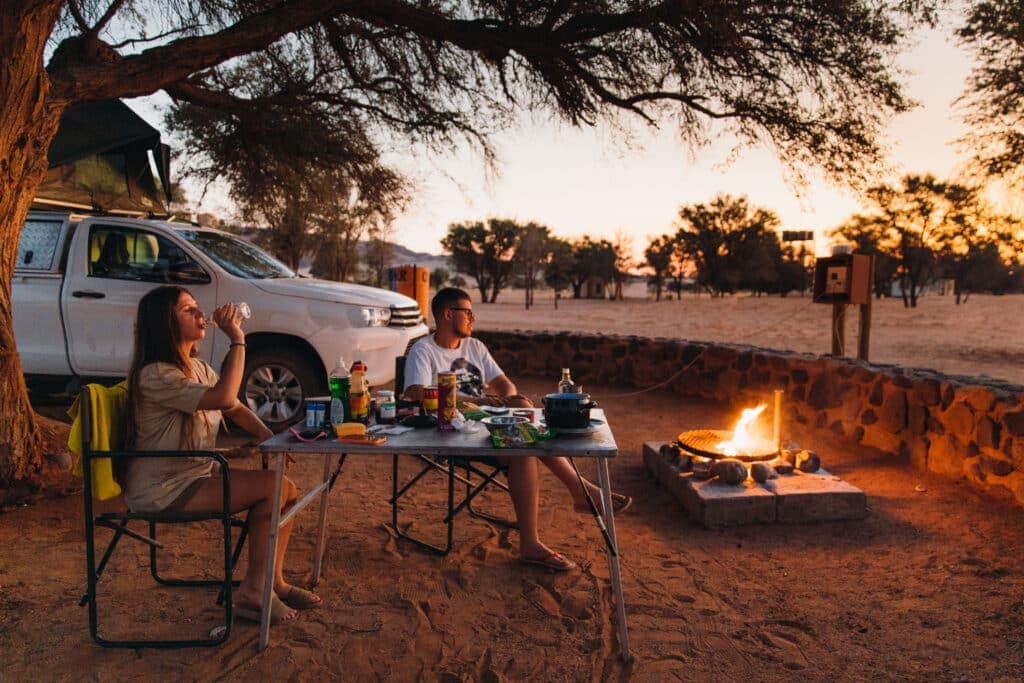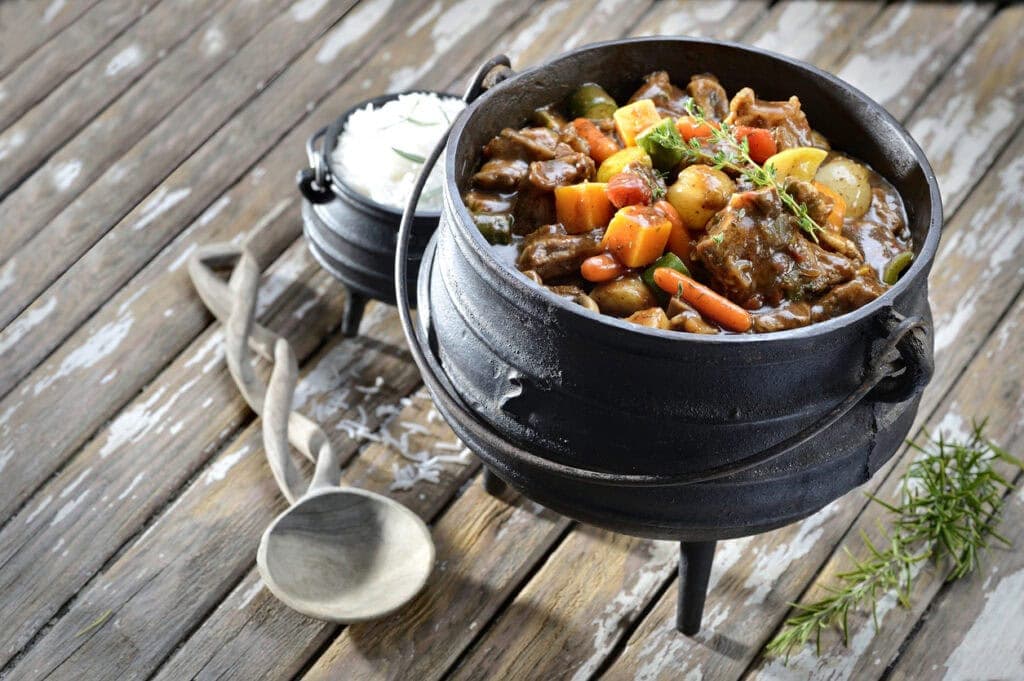Nestled along the southwestern coast of Africa, Namibia, a country of spectacular arid landscapes featuring abundant wildlife and ancient rock art, also offers a rich culinary heritage.
Traditional Namibian food boasts a unique, vibrant diversity unlike any other you may have encountered on your safari tours or holiday visits. Hearty stews, delectable barbecues, seafood delicacies, and vegetarian dishes in Namibian cuisine reflect the rich history and culture of the indigenous tribes and the fusion of European influences.

Get ready to embark on a gastronomic adventure in Namibia! We’ll introduce you to the local dishes in Namibia that are a must-try when visiting this enchanting African nation. And we’ll take you on a Namibian culinary tour of restaurants and eateries known for their authentic preparations.
What are popular local Namibian cuisines?
Kapana

Cuisine in Namibia is famous for its grilled meats, regionally known as braai, and kapana ranks among the most loved variations. This tasty street food favorite consists of marinated grilled meat, usually locally sourced beef, seasoned with chili spices and salt and served on skewers or wrapped in paper. Native Namibian food blogger Ester Kocht describes kapana as “juicy, beautifully tender, smoky.”
Oshithima
A porridge-like dish, oshithima has been a staple in Northern Namibian households and Owambo culture for centuries. To prepare this traditional Namibian food, gradually add a varied combination of pearl millet, locally known as “mahangu,” and maize flour to a large pot of boiling water, stirring frequently until it reaches the desired stiff consistency and serve with stews, soups, or Kapana.
Potjiekos

The love for meaty dishes stands out in the Namibian food culture. A Dutch-influenced dish, potjiekos, which translates to “small pot food,” features a stew of tender chunks of beef, lamb, or game meat, accompanied by an assortment of vegetables such as potatoes, carrots, onions, and cabbage and a variety of herbs, spices, and sauces.
Meliepap
The food in Namibia today, including Meliepap, often traces its origins to the Afrikaans culture, a mix of Dutch, German, and French influences. Like polenta or grits, simmer maize meal, milk, butter, and sugar until a smooth and creamy consistency is achieved. This versatile dish may be eaten for breakfast or as a savory side with “braaivleis,” barbequed meat.
Biltong

A staple in Namibian cuisine, this cured and air-dried meat has its roots in the early Dutch and Afrikaner settlers who used to preserve meat during their long journeys. Traditionally made from beef, biltong can also be prepared using game meat. The process involves marinating the meat in vinegar, spices, and salt before air-drying it for several days.
The blog Nomad Paradise states, “No South African or Namibian road trip is complete without a bag of biltongs and a bottle of sparkling water.”
Oshigali
This typical Oshiwambo and Okavango dish consists of a wholesome, flavorful bean puree. To prepare Oshigali, soak then cook peeled white beans until they become soft and easily mashed, which is then blended into a smooth and creamy consistency. Namibians often season the puree with salt and paprika to enhance the taste and serve it with a generous drizzle of Marura oil.
Boerewors
The Dutch-speaking farming community, known as the Boers, first brought this dish to Southern African and Namibian cuisine. As such, the word “boerewors” translates to “farmer’s sausage.” A combination of beef, pork, goat, or lamb, and various spices, become encapsulated in a natural casing made from sheep or ox intestines. The sausage is typically cooked on a barbecue grill or braai, giving it a smoky, flavorful taste.
Zambezi Bream
Of all the Namibian seafood delicacies, Zambezi Bream tops the list for a true taste of traditional Namibian food. Found throughout the river systems in Southern Africa, this freshwater dwarf fish is prepared by marinating it in a blend of local spices and herbs and cooked over an open fire or grilled, bringing out its natural flavors and giving it a smoky taste.
Oodhingu
Also known as dried meat, this traditional delicacy consists of preserving meat. It has a rich cultural background and history, hailing from when refrigeration was unavailable.
Commonly prepared by several indigenous tribes across many countries in South Africa, Oodhingu is prepared from fresh meat cut into strips and left to air-dry under the scorching sun until it becomes dehydrated and chewy. Serve Oodhingu with maize pap and fresh, steamed spinach.
Oshikwiila
Also known as Millet or Mahangu Pancake, Oshikwiila is a grain-based pancake traditionally enjoyed by Namibian schoolchildren to fuel them on their long walks to school. Millet grains are ground into Mahangu flour and seasoned with a pinch of salt and sugar. The addition of Marula kernel paste and water creates a batter that’s poured on a hot griddle until it forms a golden, crispy pancake.
Fat Cakes

Known as “Oukuki’ in Oshiwambo or “Vetkoek” in Afrikaans, the delicious treat most often referred to as fat cakes is a decadent ball of deep-fried dough. Preparing vetkoek entails mixing flour, yeast, sugar, salt, and water to form a soft dough. After allowing it to rise, small balls of dough are deep-fried until golden brown and crispy on the outside while remaining fluffy and soft inside.
Fat cakes are commonly served with savory fillings. Food blogger Sommer Collier shared how her daughter, who recently visited Southern Africa, enjoyed them “with sharp cheddar cheese and jam.”
The Best Places to Try Traditional Namibian Food
- For the best kapana in Namibia, go to the Oshetu market, also known as Single Quarters in Katutura, for kapana grilled to perfection right in front of you.
- The Xwama Traditional Restaurant in Windhoek, Namibia, offers many traditional Namibian dishes including oshithima.
- Stop by the Green Basket Cafe on the main road through Katima Mulilo for a satisfying breakfast of meliepap or fat cakes.
- Joe’s Beer House in Windhoek offers the best combination of Namibian and German cuisine.
- For French and African gourmet cuisine, you’ll be impressed with Leo’s at Castle in Windhoek.
- Namibian seafood delicacies abound at both The Tug Restaurant and Jetty 1905 in Swakopmund, Namibia.
Are you inspired to experience authentic Namibian cuisine firsthand? If so, get started planning your adventure to Namibia with Discover Africa! Reach out today to receive free planning advice from our destination experts.
Author: Devryn Panaino
Published:
Last Update:
Part of the Namibia Safari Collection